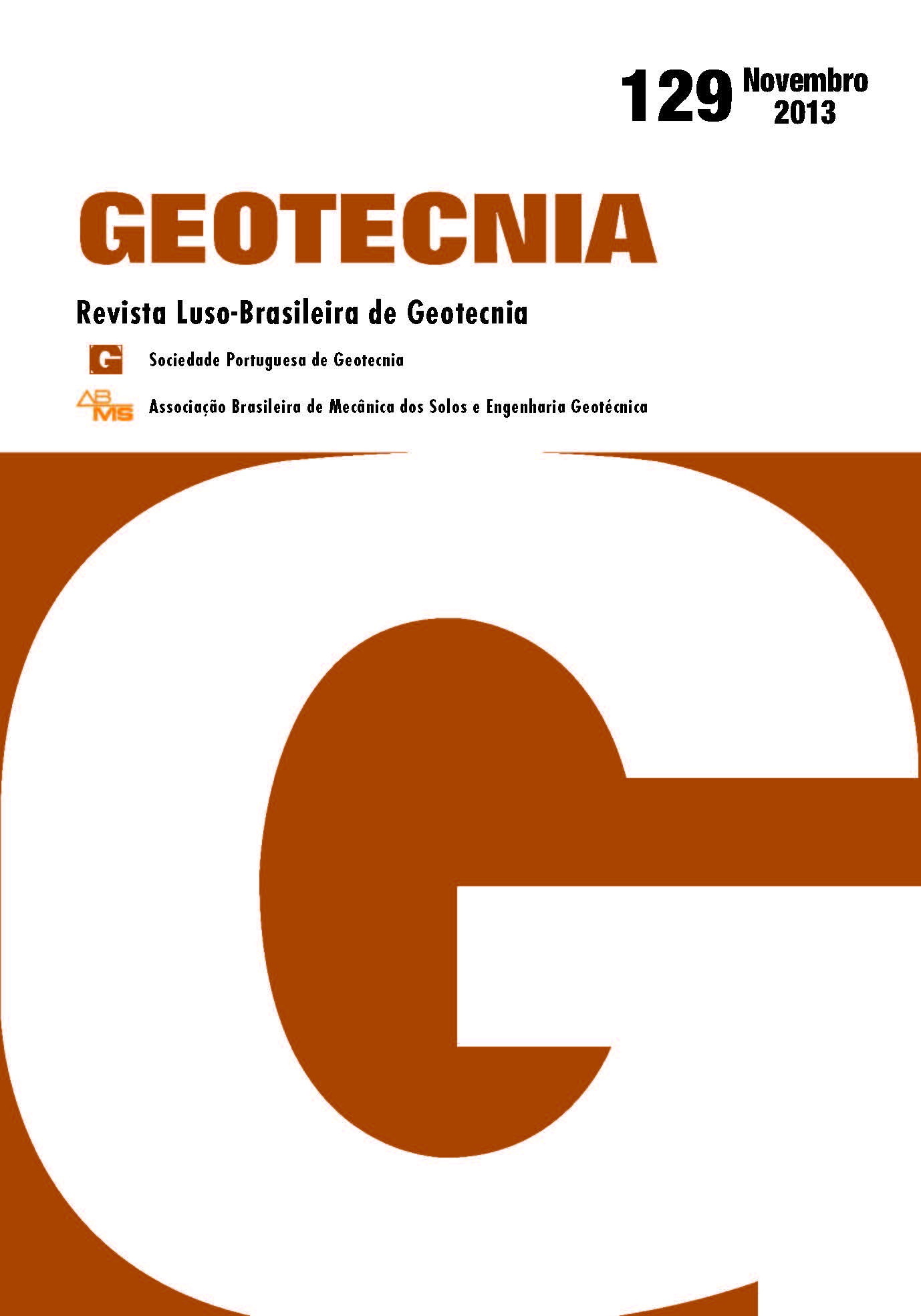Um modelo discreto de partículas 2D para simulação da fratura em rocha: formulação e calibração
DOI:
https://doi.org/10.14195/2184-8394_129_4Palabras clave:
Modelo de partículas, fratura em rocha, estudos paramétricosResumen
Modelos detalhados de partículas têm sido adotados na modelação da fratura em materiais quase frágeis. Neste artigo é adotado um modelo de partículas 2D que tem sido desenvolvido tendo em vista o estudo da fratura em rocha. Os sistemas de partículas são gerados com base num algoritmo de geração de partículas poligonais baseado nos Voronois de Laguerre da triangulação de Delaunay dos centros de gravidade das partículas circulares. O modelo de partículas poligonais, aproximado através de partículas circulares que interagem entre si através de um esquema de contacto múltiplo, é validado em ensaios biaxiais, e em ensaios do tipo Brasileiro, em rocha. São apresentados vários estudos paramétricos que permitem identificar a influên cia dos parâmetros micromecânicos nas propriedades macroscópicas, elásticas e resistentes. É por fim analisada a relevância de um modelo de contacto com leis de enfraquecimento bilinear em tração e corte de modo a obter valores coerentes de tração última nos ensaios diretos e nos ensaios Brasileiros.
Descargas
Citas
Azevedo, N. (2003). A rigid particle discrete element model for the fracture analysis of plain and reinforced concrete. PhD Thesis. Heriot-Watt University, Scotland.
Azevedo, N.; Lemos, J.V. (2005). A generalized rigid particle contact model for fracture analysis, International Journal for Numerical and Analytical Methods in Geomechanics, 29, pp. 269-285.
Azevedo, N.; Lemos, J.V. (2011). Particle geometry effect in rock fracture using a rigid particle discrete element method. Congress on Numerical Methods in Engineering. Coimbra.
Bieniawski, Z. (1967). Mechanism of brittle fracture of rock. International Journal of Rock Mechanics and Mining Science & Geomechanics Abstracts, 4, pp. 395-430.
Brace, W.; Paulding, B.; Scholz, C. (1966). Dilatancy in the fracture of crystalline rocks. Journal of Geophysical Research, 71, pp 3939–3953.
Cho, N.; Martin C.D.; Sergo D.C. (2007). A clumped particle model for rock. International Journal of Rock Mechanics & Mining Sciences, 44, pp. 997-1010.
Cundall, P.A. (1971). A computer model for simulating progressive, large-scale movements in blocky rock systems. Proceedings of the Symposium of the International Society for Rock Mechanics, Nancy 2, No.8.
Cundall, P.A.; Strack, O.D.L. (1979). A discrete numerical model for granular assemblies. Géotechnique, 29, No. 1, pp. 47-65.
Cundall, P.A. (1987). Distinct element models of rock and soil structure. Analytical and Compu ta - tio nal Methods in Engineering Rock Mechanics, E. T. Brown, Ed., Ch. 4, pp.129-163. London: George Allen & Unwin.
Diederichs, M.S. (2000). Instability of hard rock masses: the role of tensile damage and relaxation. PhD Thesis. University of Waterloo.
Diederichs, M.S. (2003). Rock Fracture and Collapse Under Low Confinement Conditions. Rock Mechanics and Rock Engineering, 36, pp. 339-381.
Erarslan, N.; Williams, D. (2012). Experimental, numerical and analytical studies on tensile strength of rocks. International Journal of Rock Mechanics & Minning Sciences, 49, pp. 21-30.
Fahimifar, A.; Malekpour, M. (2012). Experimental and numerical analysis of indirect and direct tensile strength using fracture mechanics concepts. Bulletin of Engineering Geology and the Environment, 71, pp. 269–283. Springer.
Hentz, S.; Daudeville, L.; Donze, V. (2004). Identification and Validation of a discrete element model for concrete, Journal of Engineering Mechanics ASCE, 130 (6), pp. 709-719.
Hoek, E.; Brown, E.T. (1980). Underground excavations in rock, Institute of Mining and Metallurgy. London.
Itasca, UDEC (2004). Universal Distinct Element Code, Version 4.0, Itasca consulting group, Minneapolis.
Kazerani, T.; Zhao, J. (2010). Micromechanical parameters in bonded particle method for modelling of brittle material failure. International Journal for Numerical and Analytical Methods in Geomechanics, 34, pp. 1877-1895.
Kazerani, T. (2011). Micromechanical study of rock fracture and fragmentation under dynamic loads using discrete element method. PhD Thesis. Lausanne, Switzerland.
Klanphumeesri, S. (2010). Direct tension tests of rock specimens. MSc Thesis. Suraranee University of Technology, Thailand.
Lan, H.; Martin, C.D.; Hu, B. (2010). Effect of Heterogeneity of brittle rock on micromechanical extensile behaviour during compression loading. Journal of Geophysical Research, 115, pp. 1-14.
Lemos, J. V. (2004). Os modelos de elementos discretos em geomecânica - evolução e perspectivas futuras. Geotecnia - Revista da Sociedade Portuguesa de Geotecnia, 100, pp. 333-344.
Lilliu, J.; Van Mier, M. (2003). 3D lattice type fracture model for concrete, Engineering Fracture Mechanics, 70 (7-8), pp. 841-927.
Martin, C.D.; Chandler, N.A. (1994). The progressive fracture of Lac du Bonnet granite. International Journal of Rock Mechanics and Mining Sciences and Geomechanics Abstracts, 31, pp. 643–659.
Meguro K.; Hakuno, M. (1989). Fracture analysis of concrete structure by the modified distinct element method. Structural Engineering / Earthquake Engineering, 6 (2), pp. 283-294.
Okabe, A.; Boots, B.; Sugihara, K. (1992). Spatial tesselations. Concepts and Applications of Voronoi Diagrams. Wiley Series in Probability and Statistics.
Potyondy, D.; Cundal, P. (1996). Modeling rock using bonded assemblies of circular particles, 2nd North American Rock Mechanics Symposium, Aubertin et al., Eds, Balkema, pp. 1937-1944.
Potyondy, D.O.; Cundall, P.A. (2004). A bonded-particle model for rock. International Journal of Rock Mechanics & Mining Sciences, 41, pp. 1329-1364.
Potyondy, D. (2010). A grain-based model for rock: approaching the true microstructure. Pro - ceedings, Bergmekanikk i Norden 2010 — Rock Mechanics in the Nordic Countries, 41, C. C. Li et al., Eds, pp. 225-234. Norway.
Rokugo, K. (1989). Testing method to determine tensile softening curve and fracture energy of concrete. Fracture toughness and fracture energy, pp. 153-163. Balkema.
Schlangen, E.; Garboczi, E. (1997). Fracture simulation of concrete using lattice models: Com pu - ta tional aspects. Engineering Fracture Mechanics, 57, pp. 319-332.
Underwood, P. (1983). Dynamic relaxation. Computational Methods for Transient Analysis, pp. 246-265. (T. Belytschko & T.J.R. Hughes, Eds.) New York: North-Holland.
Vasconcelos, G. (2005). Investigação experimental na mecânica da alvenaria de pedra: Carac te - ri zação de granitos e comportamento de paredes antigas de alvenaria de pedra. PhD Thesis. Universidade do Minho, Portugal.
Wang, Y.; Tonon, F. (2009). Modeling Lac du Bonnet granite using a discrete element model, International Journal of Rock Mechanics & Mining Sciences, 46, pp. 1124-1135.




